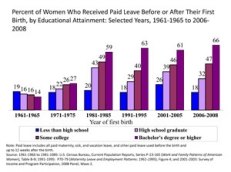
An official website of the United States government
Here’s how you know
Official websites use .gov
A .gov website belongs to an official government organization in the United States.
Secure .gov websites use HTTPS
A lock (
) or https:// means you’ve safely connected to the .gov website. Share sensitive information only on official, secure websites.
-
//
- Census.gov /
- Random Samplings /
- Access to Paid Leave Varies by Education for New Moms - Leave Varies by Education for New Moms
Access to Paid Leave Varies by Education for New Moms - Leave Varies by Education for New Moms
Access to Paid Leave Varies by Education for New Moms - Leave Varies by Education for New Moms
Paid maternity allows new mothers time to care for their newborns and provides economic security while they are away from work. While the Family and Medical Leave Act, passed in 1993, entitles new parents to unpaid leave for up to 12 weeks, new mothers use a variety of options to meet the demands of their new role, including paid leave, unpaid leave, disability, even quitting or leaving their jobs.
Instead, working mothers often rely on their employers for paid or unpaid leave benefits. More and more employers are offering such benefits to retain employees and not train new ones. Just over a third of first time mothers received paid leave in the early 1980s. By 2008, 51 percent of first time mothers received paid leave.
Access to paid leave can vary greatly by age, number of hours worked and education. Educational attainment serves as a useful proxy for the type of jobs one holds, the wages one earns, and in turn, the type of maternity leave benefits offered. Increasing levels of education go hand-in-hand with increases in the use of paid leave benefits. The relationship between educational attainment and use of paid leave began to appear in the early 1970s and pronounced by the early 1980s. The percentage of women with a bachelor’s degree or more who received paid leave increased from 27 percent in 1971-1975 to 59 percent for those with a first birth between 1981 and 1985, and grew to 66 percent of new mothers between 2006 and 2008. The use of paid leave by mothers with less than a high school degree was 18 percent in 2006-2008, about what it was for previous time periods.
Share
 Yes
Yes
 No
NoComments or suggestions?


Top

